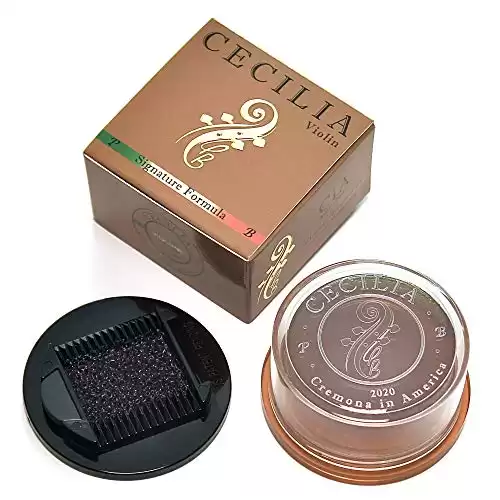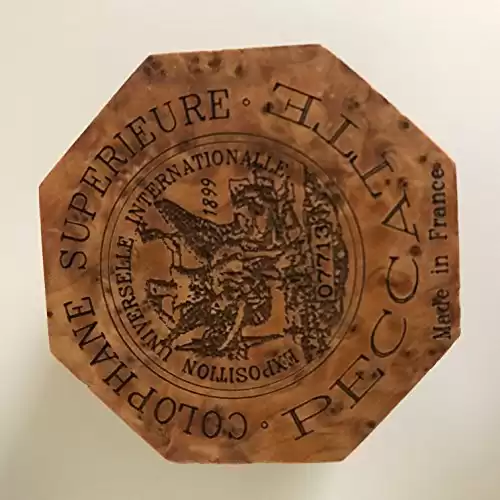Have you ever run a bow across violin strings? If you did, the chances are that the sounds you created didn’t match your expectations.
That’s because violinists use rosin while playing their instrument. When it is applied correctly, the bow can run across the strings more consistently to produce the desired sound.
It would be best to cover the bow with an even coat of rosin to have a successful experience. If too little gets used, there won’t be enough string grip. It can be problematic when you have too much since it can feel sticky and become challenging to remove.
It’s often better to proceed cautiously when working with rosin. Your bow needs a new application after about three to five hours of actual playing time.
If you’re a student or only play periodically, you might need to apply rosin about twice per week.
What Is Rosin and Why Do Violinists Need It?
Rosin is the solid form of resin. It comes from different conifer trees, such as pine. It gets produced by heating the liquid resin until the volatile components vaporize, creating a semi-transparent product. Violinists use it to help the bow grip the strings to have consistent notes.
Violinists often apply rosin to their instrument before playing it to ensure the results are what they expect. This product comes in several forms, including cakes, blocks, and powder. Since it is a natural item, you’ll also see coloration differences.
Rosin comes in options that range from yellow to black.
Most of today’s rosin comes from pine sap, although any conifer is suitable. It’s usually extracted from the trees that farmers or facilities grow to produce paper pulp.
The first step during the manufacturing process is to heat the pulverized natural materials to separate the wood and fibers from the tree’s byproducts. After the aromatic compounds are removed, the raw items get converted into rosin using beeswax, some molds, and proprietary ingredients.
This new material gets heated and cooled until it can form a specific shape. A torching process smooths the surface once it’s removed from the mold, creating a cake that musicians can use for their violin.
Should I Get Boxed or Cake Rosin for the Violin?
You’ll find three options available when shopping for rosin: powder, cake, and boxed. Some manufacturers sell a full-size or half-size option to expand their product offerings.
If you want something quick and affordable, boxed rosin is the best choice to consider. It’s a universal product that works for virtually any stringed instrument. It applies smoothly to bows constructed of materials other than horsehair, providing the correct levels of stickiness to accommodate your playing style.
Boxed rosin has more durability than cakes. It’s less prone to breaking or cracking, which means you’ll get more life out of a single investment.
When you need something made of a higher quality, you’ll want to invest in cake rosin. You’ll find numerous colors available, ranging from amber to jade to black.
The cake style is a little harder to use because it delivers a softer application experience. That’s why it is the preferred item for musicians who play with horsehair bows. It also stands up to certain weather conditions better.
Rosin powder is rarely used for playing the violin. That’s because it is used as a glazing agent for numerous products, including soap, soda, and sealing wax.
If you decide to use the powdered product, it works better to place it on a felt cloth or pad to apply it directly to the bow.
Most violinists use a light or medium rosin if they’re selecting an all-purpose product for stringed instruments. Although heavy options can deliver results in some situations, there is too much “stick” for the bow to be appropriately managed.
Best Rosin Products to Purchase for the Violin
If you are just starting to play the violin or have been disappointed by previous rosin purchases, upgrading to today’s best products is an investment worth considering. You’ll find that these cakes, half-cakes, and other styles are easy to use and can improve your consistency when playing dramatically.
1. Cecilia Signature Formula Violin Rosin
When you select the Cecilia Signature Formula Violin Rosin for your bow, you’ll be using a product that benefits from a new liquid form blending method. It delivers a unique playing sensation when contacting the strings, producing a defined and instantly noticeable reaction. You’ll get richer, fuller tones without dealing with excessive bite.
Although the manufacturer produces four different types, it is better to stick with the signature formula. After melting the initial resin, the liquid goes through a proprietary filtering screen to blend the ingredients with more consistency. It delivers a medium grip, no harsh tones, and a shape that works well for application.
2. Saroty Violin Rosin
If you only need a light grip for your violin, the Sartory Peccatte Violin Rosin offers a dark, beautiful, and easily appliable user experience. The precise blend delivers an excellent result with a generous cake that will last for a long time. What stands out is that the item gets mounted on natural cork to offer more protection, and each collector’s wood case comes with a unique serial number.
You’ll still get an excellent bite with the product, delivering a consistent tone without grain or scratchiness. It’s a winter-style option that works better with some humidity, and you’ll get positive results all year. The wooden box does require some care to use, but the advantages at this price point are hard to ignore.
3. Jade L’Opera Rosin for Violin
When you select this rosin to use for your violin, you’ll receive all-season support in an affordable package. It’s made in France using a several centuries-old recipe, and it only takes a few bow strokes to get what you need. Since this product comes in a green color, you’ll find that the hairs could turn the same shade as time passes.
The Jade L’Opera Rosin for Violin is a little more complex than you might expect. It works well for those who have a scratchy technique or play more of the fiddle style with the instrument. You’ll want to be careful when applying to avoid having it start chipping.
Why Do I Feel Bad after Using Natural Rosin?
An issue that impacts many violinists is an allergy to rosin products. Although it doesn’t affect everyone, the dust that comes from the bow application can trigger unwanted symptoms when it gets breathed.
Natural products typically create fewer allergy problems for musicians than the cheaper powders or synthesized items. When fewer chemicals or impurities are part of the recipe, it’s much easier to walk away without the same discomfort.
It is not uncommon for beginners to apply too much rosin to their instrument. In that situation, the caking tendencies of the item could be creating exposure issues. It’s often better to take your violin to a luthier or repair shop to get it cleaned.
Some musicians find it is helpful to vacuum their instrument case a couple of times per month to limit dust exposure.
If you have a rosin allergy, the following symptoms might appear at different severity levels.
- Contact Dermatitis. The most common reaction to rosin involves how the skin reacts to it. If you experience an acute problem, the skin can turn red and start swelling. It usually takes up to three days after contact with the product before the symptoms develop, which is why it isn’t always caught. It can be over a week for others. You’ll notice blistering, itchiness, and discomfort as the reaction spreads.
- Breathing Trouble. If you breathe the dust from a rosin application, an allergic reaction might trigger swelling within your air passageways. Should this reaction occur, you’ll want to treat the situation as a medical emergency.
- Lichenified Skin. When someone receives multiple rosin exposures and allergic reactions, it can cause an acute problem to become chronic. The most common result from this issue is to have the tissues turn leathery and thick. You’ll need to apply moisturizers more often, and your doctor might recommend a topical steroid.
There is no mechanism for desensitizing your body to a rosin allergy. Once it appears, it becomes part of who you are. Your treatment plan typically follows the same course as someone with eczema or dermatitis.
The best way to avoid a rosin allergy while playing the violin is to avoid having contact with the cakes, blocks, or powders with your skin. If you’re highly sensitive to the product, it might be necessary to speak with an experienced dermatologist to see if there are additional strategies for you to follow.
How to Clean Rosin off Your Violin
Rosin dust eventually collects on your violin as the bow comes across the strings. In most situations, you can clean up the instrument with a few essential items.
The best option is to get a soft cotton rag with warm water to run over the violin. Once you’ve given it a good cleaning, dry it immediately with a microfiber cloth. If you allow the moisture to get into the wood, it could expand and change how the instrument plays.
Some musicians find that the rosin dust accumulates on the instrument’s varnish. That’s when it is time to send it to a luthier or a professional cleaner to restore the violin’s appearance. You’d want to take this step if you cannot reach some of the dusty parts with your current equipment.
Best Violin to Use with Light or Medium Rosin
If you’re looking to upgrade your current instrument because you’ve been on a beginner’s violin, the D Z Strad Model 505F is an excellent choice to consider. It’s a Stradivarius advanced masterpiece copy produced in the 4/4 full size. You’ll see a maple finish with meticulous handmade details, including a beautiful inlay created by some of today’s best luthiers.
The ribs and scroll are also made from maple, naturally air-dried before assembly to ensure you receive the purest tones possible. You’ll find the sound is remarkably sophisticated and aged, even though you’re getting a brand-new instrument. The ring and color are better than what you’ll find in pro-quality violins that cost $10,000 or more.
When you bring home the D Z Strad Model 505F, you’ll be getting a package that contains two bows, a shoulder rest, a case, and the rosin needed for a successful playing experience.
The bows are made from Brazilwood and Carbon Fiber to ensure that you can take advantage of both playing styles. It’s even subjected to an antiquing process that improves the visual aesthetics of the instrument to make it feel like the appearance matches the tone.
It really is a fantastic instrument that is worth the investment.
A Final Thought about Using Rosin for Your Violin
It’s easy to blame the rosin for a poor playing performance. Some students get frustrated by how their instrument sounds, even with lots of practice each week, which causes them to keep switching cakes, boxes, or powders.
Unless your instructor has seen your bow preparation rituals and suggests a different type would help, you’ll want to focus on your playing style first.
If you’re trying to learn how to play the violin alone, you’ll want to look for darker rosin first. These products typically deliver a better grip while your bowing skills improve.
Since a rosin cake can last for a long time, you’ll want to consider spending enough to get a high-quality product. When you get an item in the $25 to $50 range, you’ll typically hear richer sounds coming from the strings.
Humidity and temperature will affect the rosin’s consistency. If you live in an extreme climate, it might be necessary to purchase a different cake, box, or powder for each season.
Playing the violin is a lot of fun. The soulful sounds it produces can stir emotions in ways that other instruments cannot replicate!
When you pair the right instrument to its proper rosin, you’ll have a better playing experience.





